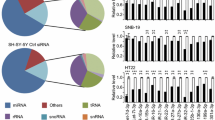Abstract
Autophagy is a cellular survival pathway that is necessary for the degradation of cellular constituents such as long-lived proteins and damaged organelles. Conditions resulting in cellular stress such as starvation or hypoxia might activate autophagy. Being at the crossroads of various cellular response pathways, dysregulation of autophagy might result in pathological states including cancer and neurodegenerative diseases. Autophagy has also been shown to participate in stemness. MicroRNAs were introduced as novel regulators of autophagy, and accumulating results underlined the fact that they constituted an important layer of biological control mechanism on the autophagic activity.
MicroRNAs are protein noncoding small RNAs that control cellular levels of transcripts and proteins through posttrancriptional mechanisms. Novel miRNAs in human and mouse genomes are yet to be identified. Considering the emerging role of autophagy in health and disease, identification of novel autophagy-regulating miRNAs and determination of relations between miRNA expression and physiological and pathological conditions might contribute to a better understanding of mechanisms governing health and disease. High-throughput techniques were developed for miRNA profiling, yet for a thorough characterization and miRNA target determination, miRNA cloning remains as an important step. Here, we describe a modified miRNA cloning method for the characterization of novel autophagy-regulating miRNAs.
Similar content being viewed by others
References
Ravikumar B, Sarkar S, Davies JE, Futter M, Garcia-Arencibia M, Green-Thompson ZW et al (2010) Regulation of mammalian autophagy in physiology and pathophysiology. Physiol Rev 90(4):1383–1435. https://doi.org/10.1152/physrev.00030.2009
Gozuacik D, Kimchi A (2004) Autophagy as a cell death and tumor suppressor mechanism. Oncogene 23(16):2891–2906. https://doi.org/10.1038/sj.onc.1207521
Pan H, Cai N, Li M, Liu G, Belmonte J (2013) Autophagic control of cell stemness’. EMBO Mol Med 5(3):327–331. https://doi.org/10.1002/emmm.201201999
Liu F, Lee JY, Wei H, Tanabe O, Engel JD, Morrison SJ et al (2010) FIP200 is required for the cell-autonomous maintenance of fetal hematopoietic stem cells. Blood 116:4806–4814. https://doi.org/10.1182/blood-2010-06-288589
Salemi S, Yousefi S, Constantinescu MA, Fey MF, Simon H-U (2012) Autophagy is required for self-renewal and differentiation of adult human stem cells. Cell Res 22:432–435. https://doi.org/10.1038/cr.2011.200
Vazquez P, Arroba AI, Cecconi F, de la Rosa EJ, Boya P, de Pablo F (2012) Atg5 and Ambra1 differentially modulate neurogenesis in neural stem cells. Autophagy 8:187–199. https://doi.org/10.4161/auto.8.2.18535
Tra T, Gong L, Kao LP, Li XL, Grandela C, Devenish RJ et al (2011) Autophagy in human embryonic stem cells. PLoS One 6:e27485. https://doi.org/10.1371/journal.pone.0027485
Menendez JA, Vellon L, Oliveras-Ferraros C, Cufi S, Vazquez-Martin A (2011) mTOR-regulated senescence and autophagy during reprogramming of somatic cells to pluripotency: a roadmap from energy metabolism to stem cell renewal and aging. Cell Cycle 10:3658–3677. https://doi.org/10.4161/cc.10.21.18128
Kim VN (2005) MicroRNA biogenesis: coordinated cropping and dicing. Nat Rev Mol Cell Biol 6(5):376–385. https://doi.org/10.1038/nrm1644
Gozuacik D, Akkoc Y, Ozturk DG, Kocak M (2017) Autophagy-regulating microRNAs and cancer. Front Oncol 7. https://doi.org/10.3389/fonc.2017.00065
Barad O, Meiri E, Avniel A, Aharonov R, Barzilai A, Bentwich I et al (2004) Micro-RNA expression detected by oligonucleotide microarrays: system establishment and expression profiling in human tissues. Genome Res 14(12):2486–2494
Chen C, Ridzon DA, Broomer AJ, Zhou Z, Lee DH, Nguyen JT et al (2005) Real-time quantification of microRNAs by stem-loop RT-PCR. Nucleic Acids Res 33(20):e179
Lee RC, Ambros V (2001) An extensive class of small RNAs in Caenorhabditiselegans. Science 294(5543):862–864
Lau NC, Lim LP, Weinstein EG, Bartel DP (2001) An abundant class of tinyRNAs with probable regulatory roles in Caenorhabditis elegans. Science 294(5543):858–862
Lagos-Quintana M, Rauhut R, Yalcin A, Meyer J, Lendeckel W, Tuschl T (2002) Identification of tissue-specific microRNAs from mouse. Curr Biol 12(9):735–739
Lu C, Meyers BC, Green PJ (2007) Construction of small RNA cDNA libraries for deep sequencing. Methods 43:110–117. https://doi.org/10.1016/j.ymeth.2007.05.002
Gu W, Shirayama M, Conte D, Vasale J, Batista PJ, Claycomb JM et al (2009) Distinct argonaute-mediated 22G-RNA pathways direct genome surveillance in the C. elegans germline. Mol Cell 36:231–244. https://doi.org/10.1016/j.molcel.2009.09.020
Fu H, Tie Y, Xu C, Zhang Z, Zhu J, Shi Y, Jiang H, Sun Z, Zheng X (2005) Identification of human fetal liver miRNAs by a novel method. FEBS Lett 579(17):3849–3854. https://doi.org/10.1016/j.febslet.2005.05.064
Author information
Authors and Affiliations
Corresponding author
Editor information
Editors and Affiliations
Rights and permissions
Copyright information
© 2017 Springer Science+Business Media New York
About this protocol
Cite this protocol
Ozturk, D.G., Kocak, M., Gozuacik, D. (2017). Cloning of Autophagy-Related MicroRNAs. In: Turksen, K. (eds) Autophagy in Differentiation and Tissue Maintenance. Methods in Molecular Biology, vol 1854. Humana Press, New York, NY. https://doi.org/10.1007/7651_2017_83
Download citation
DOI: https://doi.org/10.1007/7651_2017_83
Published:
Publisher Name: Humana Press, New York, NY
Print ISBN: 978-1-4939-8747-4
Online ISBN: 978-1-4939-8748-1
eBook Packages: Springer Protocols




